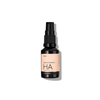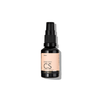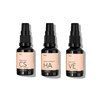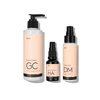Our Ultimate Guide to Layering Serums
Easy to absorb and jam-packed with targeted ingredients, face serums are some of the most hard-working products you can use on your skin. In fact, they’re so effective that you might want to layer more than one.
After all, more hydrating, skin-brightening, and anti-ageing goodness means better skin, right?
It is true that layering facial serums is a great way to enhance your complexion. But you should know how to layer skincare serums properly and which ones work well together before getting started.
To help you get the most out of your skincare routine, we’ve put together this complete guide to layering serums. You’ll learn how to layer face serums, when to put them on, and which ones best support each other when combined.
What Do Serums Do for Your Skin?
Let’s start with what serums do for your skin. Face serums are highly concentrated skincare products formulated to target specific skin concerns. They usually contain one or two main active ingredients, so you can use them to hone in on your skin’s biggest challenges.
Dark spots, fine lines, a dull complexion – whatever you want to improve about your skin, there’s a serum that can help. Better yet, that little drizzle of serum delivers a far more potent dose of ingredients that penetrate the dermis easier and deeper than cream-based products.

When Should You Layer Skincare Serums?
When you want to address multiple skin concerns, layering serums works wonders. For example, if you want to target adult acne while also protecting your skin from the effects of ageing, you might choose a retinol serum and a hydrating serum.
Depending on the types of serums you’re using, combining products can also enhance the effects overall. Some ingredients, like vitamin C and collagen, work synergistically. These two ingredients combine forces to create younger-looking skin.
Vitamin C is an ingredient proven to help aid in the natural production of collagen, and when combined or layered with, can actually add to the efficacy of a collagen serum.
How Many Face Serums Should You Use?
Experts recommend using no more than two to three serums in your daily routine. There are a couple of reasons why you don’t want to go overboard with serums.
- When you apply a face serum, it’s going to absorb quickly and start going to work for your skin. Too many active ingredients at the same time can actually overwhelm your skin, which can leave it feeling irritated or more sensitive than usual.
- Applying too many layers can reduce the penetration of your serums. So with each subsequent layer, the effectiveness of your active ingredients might diminish.
Which Serums Work Well Together?
When learning how to layer skincare serums, there are a few basic rules you’ll want to keep in mind to give your skin all the skin-enhancing goodness you possibly can. The reality is that some skincare serums act like they were made for one another. And others simply don’t do well when applied at the same time. Let’s take a look at the dos and don’ts of layering face serums.
Serums you can layer
Vitamin C and hyaluronic acid: These two anti-ageing skincare ingredients are a match made in heaven. Vitamin C protects against free radical damage and brightens the skin, while hyaluronic acid locks in moisture, creating a plumping effect. These serums can work together to reduce fine lines and wrinkles.

Hyaluronic acid and retinol: If you’re looking for a skin-smoothing combo, these two serums pair well together. Hyaluronic acid is ultra-hydrating, while retinol goes to work repairing skin to create a more even texture. Even better, hyaluronic acid helps to balance out the drying effects of retinol.
Vitamin B3 and B5: For a calming, anti-acne serum routine, layer a vitamin B3 (niacinamide) and vitamin B5 (panthenol) serum. Vitamin B3 helps to manage sebum levels and minimise the appearance of large pores, while vitamin B5 is an excellent skin soother. It calms inflammation while also hydrating.
In general, you can freely layer nourishing and hydrating serums. These products won’t contradict each other, and they can enhance the benefits your skin receives. Antioxidant serums work well together, too, especially a vitamin C serum with any other antioxidant, such as vitamin E, retinol, and ferulic acid.
Serums that don’t work well together
You shouldn’t use skincare serums that can be irritating or drying together. Retinol serums and those that contain exfoliating or anti-acne ingredients like alpha-hydroxy acids (AHAs) and beta-hydroxy acids (BHAs) are best combined with emollient or calming serums instead of one another.
Also, avoid layering oil-based and water-based serums. Because of the way oil and water behave, your serums could repel one another. If you want to use a water-based and oil-based serum, apply one during your morning routine and the other during your evening skincare routine.
How to Layer Face Serums as Part of Your Daily Skincare Routine
Layering serums can enhance your skincare routine, but you want to get the process right to ensure you’re optimising your products. Here’s what you need to know about layering facial serums:
- Always apply your serums after cleansing (and toning if you use this skincare step), whether you’re applying one or more products.
- Start with the lightest serum first. If your serums have the same consistency, start with the serum that addresses your primary skincare concern.
- To apply the first serum, massage a few drops into your skin, using upward and outward motion.
- Once the first serum absorbs into your skin, apply the second. Then, follow with your moisturiser and the rest of your routine.










